June is a glorious month for wild flowers. For floral fanatics such as me, it can be a frantic time. Each day another species bursts into beautiful blooms, and I charge from wood to meadow, from roadside verge to riverside bank to catch these splendours at their best. I have to see them every year, pondering over each and every one’s exquisite beauty; it is intoxicating.
Ramblings from Finemere Wood
Common spotted orchid. Photo by Philip Precey
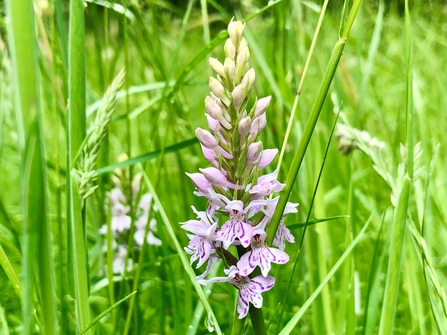
Common spotted orchid. Photo by Charlotte Karmali
In Finemere Wood, common spotted orchids are more widespread than ever before, pale pink with purple markings, they are a magnificent vision. Small white star-like flowers of lesser stitchwort are scattered throughout the open grassy areas. Herb robert with small, pretty pink crane’s-bill flowers flourishes in the shaded areas. Meadowsweet explodes with dense clusters of small white flowers.
The woodland workers are a fine sight too. Less colourful perhaps, but beautiful in their own way, and wonderful to watch as they labour away to ensure a rich habitat for these floral curiosities.
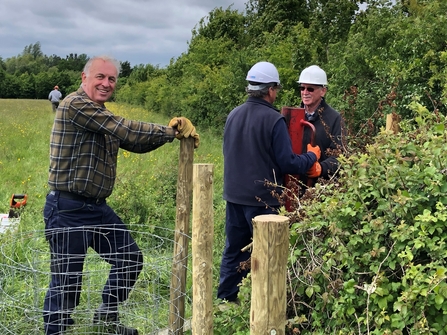
Volunteers tackling the new fencing at Finemere Wood. Photo by Charlotte Karmali
Our summer project is to replace a section of stock fencing on the adjoining meadows. Brains and brawn are both required. Deep holes must be dug for strainer posts; multiple intermediate posts must be pounded in; old fencing must be deconstructed, and post and rail sections of fencing must be created.
Like the flora I so revere, each volunteer is unique and critical to the job on hand. Some could dig to Australia, others are happy to pound away all day. Some like to demolish and others prefer to construct. It takes all sorts.
Selfheal is a valuable nectar source for many pollinators. Photo by Charlotte Karmali
Selfheal (Prunella vulgaris) is a stunner of a plant, producing clusters of violet flowers around its cylindrical flower spike, from June through to October. A creeping plant of the mint family, it can grow up to 30cm in height. It is abundant in grassy places such as open areas of woods and on untreated garden lawns.
Viewed as a troublesome weed in some gardens, I choose to nurture patches of selfheal on my lawn. It is a valuable nectar source for many pollinators, bumble bees in particular.
Prunella vulgaris has been used in herbal medicine for centuries. It is believed to stimulate the body’s own healing process, hence the name selfheal. Its uses have been plentiful: to staunch bleeding, heal wounds and treat sore throats, to name but a few.
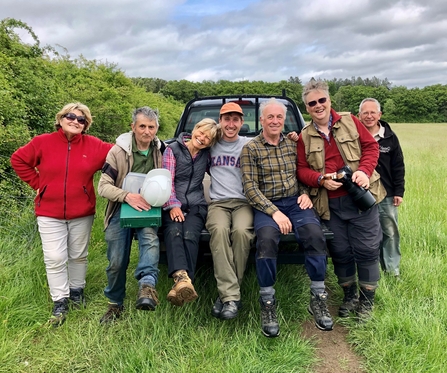
The Finemere Wood volunteers. Photo by Charlotte Karmali
Great headway has been made on the fencing front and despite the use of many a large, sharp and heavy tool, the medicinal help of selfheal was not required this month.
More than 1,700 volunteers help us towards our vision of more nature everywhere, on our nature reserves, at our visitor and education centres, in our offices and more.
Find a volunteer opportunity near you
Visit a nature reserve
Nature Discovery Centre
The Nature Discovery Centre is surrounded by a mosaic of different habitats with fantastic wildlife to see all year around.
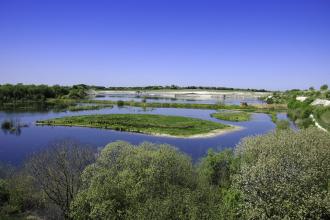
College Lake
Nature reclaimed this worked-out chalk quarry and created an outstanding centre for wildlife, which gives nature-lovers of all ages easy…
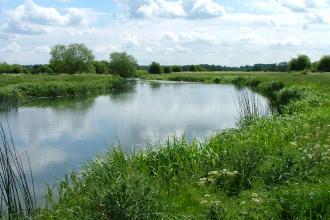
Chimney Meadows incl. Duxford Old River
An ancient landscape and a vital refuge for wading birds, Chimney Meadows is the Berks, Bucks & Oxon Wildlife Trust's largest…

Finemere Wood
A magnificent woodland - home to birds, bats and butterflies, where you can forget the stresses of everyday life.

Hook Norton Cutting
Renowned for its Jurassic fossil interest, this former railway cutting is also a wildlife gem for birds, butterflies and flowers.

Grangelands and The Rifle Range
A rich array of chalk grassland flowers and insects in an undulating landscape.

